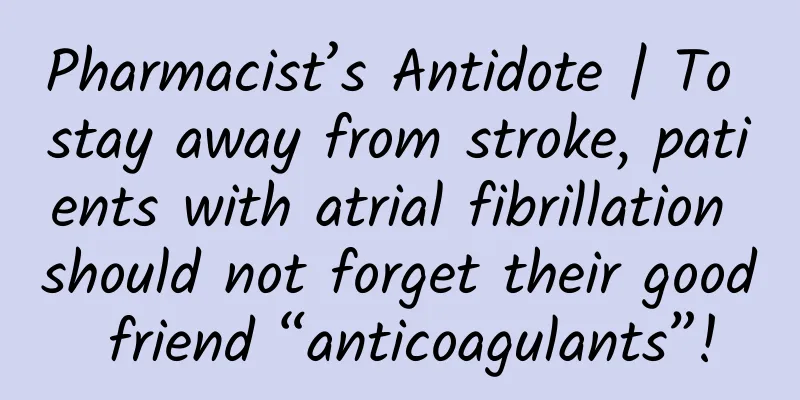Pharmacist’s Antidote | To stay away from stroke, patients with atrial fibrillation should not forget their good friend “anticoagulants”!

|
"My heart is pounding" may not mean that you have met your loved one, but it may be atrial fibrillation. Atrial fibrillation (AF) is a common arrhythmia, which manifests itself on the electrocardiogram as the disappearance of the P wave and its replacement by an irregular f wave. The most common symptom is palpitations. A small number of patients may experience chest tightness, dizziness, and blackouts, and some patients may have no obvious symptoms. As mentioned above, AF does not seem to be fatal. But there is another set of data: Compared with people without AF, patients with AF have a 4-5 times increased risk of stroke, a 2-3 times increased risk of heart failure, and a 2-fold increased risk of death. At least 1/3 to 1/4 of patients with AF suffer from ischemic stroke. Atrial fibrillation is clearly a heart problem, so how is it related to stroke? Fatal blood clots "nurtured" in the left atrial appendage The heart also has an "ear"-like structure. The left atrial appendage mentioned here refers to a blind-end-like structure below the anterior wall of the left atrium. It is responsible for regulating left ventricular filling pressure, stabilizing blood flow, and secreting atrial natriuretic peptide. The left atrial appendage is filled with blood, and it fulfills its mission conscientiously. However, when atrial fibrillation occurs, the rhythm of the left atrium, which should be beating regularly, becomes irregular, causing the connected left atrial appendage to be confused: I should just follow the rhythm of the left atrium, but now it is out of order, what should I do? Should I contract or relax? Should I pump the blood out or keep it in the left atrial appendage? As a result of hesitation, the blood in the left atrial appendage becomes stagnant and swirls, and the blood flow slows down. If the atrial wall is damaged, the blood is in a hypercoagulable state, and a thrombus will be born. The thrombus "raised" in the left atrial appendage is very unstable. It will fall off and travel around with the blood flow. If it stays in the brain, it can cause a stroke. Anticoagulants to prevent stroke are the focus of atrial fibrillation treatment The use of anticoagulants is an indispensable means to prevent thrombosis in patients with atrial fibrillation. The "Guidelines for Primary Diagnosis and Treatment of Atrial Fibrillation" formulated by the Chinese Medical Association states that "we must pay close attention to the patient's risk of thromboembolism, and anticoagulant treatment should be carried out according to the risk assessment of stroke". The American College of Chest Physicians' "Guidelines for Antithrombotic Treatment of Atrial Fibrillation and Expert Group Report" also states that comprehensive management measures for atrial fibrillation include stroke prevention, symptom improvement and risk factor control, among which stroke prevention is the central link. Doctors will conduct a score assessment called "CHA2DS2-VASc" on patients with atrial fibrillation who visit the doctor. The assessment includes age, gender, whether there is hypertension, diabetes, history of stroke, heart failure, vascular disease, etc. Patients with atrial fibrillation who score ≥1 for men and ≥2 for women need to start or consider starting anticoagulant treatment with anticoagulants. The use of anticoagulants varies from person to person At present, anticoagulant drugs used by patients with atrial fibrillation are divided into two categories: one is the vitamin K antagonist warfarin; the other is non-vitamin K antagonists, including the direct thrombin inhibitor dabigatran etexilate and the direct Xa factor inhibitors rivaroxaban and apixaban. Warfarin is a traditional anticoagulant and a very "particular" drug: if the dose is too small, the anticoagulant effect cannot be achieved; if the dose is too large, the risk of bleeding increases. Different patients have large individual differences in their dosage requirements, and they are also easily affected by food and drugs. Therefore, the dosage of warfarin is "adjusted". After 2 to 4 weeks, the international normalized ratio (INR) is measured multiple times, and the dosage is adjusted at the same time. The INR value is "adjusted" to 2.0~3.0 to reduce the risk of stroke and bleeding. Compared with warfarin, new anticoagulants such as dabigatran etexilate and rivaroxaban, which are non-vitamin K antagonists, may have better "user experience" because they do not need to routinely test coagulation function, but they are not suitable for patients with severe liver and kidney dysfunction. No matter which type of anticoagulant you choose, remember that anticoagulants are "good friends" of patients with atrial fibrillation. Do not give up easily unless there are contraindications or serious adverse reactions. Precautions for medication in patients with atrial fibrillation 1 In addition to anticoagulants, patients with atrial fibrillation may also use antiarrhythmic drugs such as amiodarone, propafenone, sotalol, and ventricular rate control drugs such as metoprolol and diltiazem. Be sure to use them as directed by your doctor. 2 Patients who use warfarin for long-term anticoagulation need to test their INR values regularly (usually once every 4 weeks) to ensure that the INR value remains between 2.0 and 3.0 for more than 60% of the time. 3 For patients receiving anticoagulant therapy using non-vitamin K antagonists such as dabigatran etexilate and rivaroxaban, liver and kidney function should be tested once a year. 4 Patients with atrial fibrillation should go to the hospital for regular follow-up visits according to the needs of anticoagulation and other treatments. When patients with atrial fibrillation receive anticoagulant treatment, in addition to preventing thrombosis, it is also important to pay attention to whether there are adverse drug reactions and deal with comorbidities. |
>>: Medicine Baby Test | Can’t erythromycin and hawthorn be taken together?
Recommend
Black discharge after painless abortion
Painless abortion is a surgery that allows women ...
Causes of swollen hands during pregnancy
It is not easy for pregnant women during the preg...
Foods that pregnant women should never eat
After a woman becomes pregnant, she needs to incr...
I regret induced abortion and can't get over it
Induced abortion is a last resort for every woman...
Does the Joyoung electric pressure cooker's reservation time start or end? How to use the Joyoung electric pressure cooker's reservation function
Joyoung electric pressure cooker is a very useful...
What are the dangers of removing the ring before menstruation
If we talk about the most long-term contraceptive...
What does the fetus' head look like at seven months of pregnancy?
When the pregnancy is around 7 months, it has ent...
Why does a woman feel weak all over and her legs feel limp?
In modern society, many female friends are both w...
Sad Nipple Syndrome Symptoms
The nipple, also called the teat, is the raised c...
Is bad breath the same as halitosis?
Wearing a mask seems to be a common thing now. I ...
What is the difference between miscarriage and abortion?
There is actually an essential difference between...
Multiple factors have led to an increase in the number of critically ill patients recently! The elderly are "positive", beware of "silent hypoxia"
How is the treatment of infected people in Beijin...
The most serious symptoms of pelvic inflammatory disease
Pelvic inflammatory disease is a very common dise...
15 Foods to Avoid During Period
Menstruation is a physiological phenomenon that o...
Why is worm-infested tangerine peel expensive? The effect of lemon tangerine peel rock sugar paste
Lemon and tangerine peel contain a lot of vitamin...









